Civic Arts
Patriot with a No. 5 paintbrush
April 14, 2010
Kent Twitchell casts a huge shadow in the Los Angeles public art world—literally.
For decades, his multi-story portraits of artists, movie stars and musicians have helped define a quintessentially L.A. cityscape as big as all outdoors.
Now he’s headed someplace new—indoors—with a task ahead of him that looms as large as ever: bringing back to life the essence of murals that vanished decades ago in the Bob Hope Patriotic Hall.
The scenes, created by Chicago-born artist Helen Lundeberg, mysteriously disappeared sometime in the ‘70s—stripped off the walls and destroyed or spirited away to points unknown.
Now the landmark 1926 building, once the county’s Hall of Records, is getting a $45.4 million renovation. As part of the project, Twitchell has come onboard to recreate and reimagine the three murals that once dominated the lobby of the building, now home to the county’s Department of Military and Veterans Affairs. 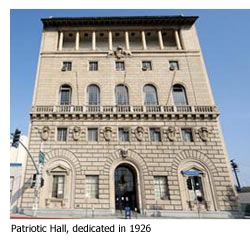
In an interview this week at his downtown studio, Twitchell discussed for the first time how he plans to approach the job. He says he intends to respect the vision Lundeberg created in 1942, while drawing on his own unique sense of aesthetics, with influences ranging from Mt. Rushmore and the Statue of Liberty to Norman Rockwell and the famous faces of Hollywood’s Golden Age.
“I happen to be a patriot,” he says. “Here’s a chance for me to be doing something I really believe in.”
Twitchell, who enlisted in the military right out of high school and went on to become an Air Force illustrator stationed in London, has an idea about the people he’ll depict in his Patriotic Hall scenes. He proposes making every figure in the murals a veteran—from character actor William Sanderson (“Newhart,” “Deadwood,” “True Blood”) to Twitchell’s octogenarian Uncle Paul. He’s also poring over WWII-era books of Hollywood luminaries to discover which ones might qualify for a cameo appearance in one of the murals. “Clark Gable flew suicide missions as a fighter pilot,” he says.
Twitchell muses about the juxtaposition of faces he envisions for the murals—“a superstar, a character actor, someone you don’t know.”
“I want to make it uniquely Los Angeles,” he says. “These are our people. That is Los Angeles.”
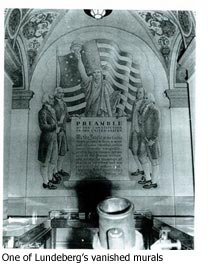 Patriotic Hall, seen by millions zipping through the intersection of the 110 and 10 freeways, is set to reopen in mid-2012. It seems particularly well-suited for a Twitchell project—and not just because it’s located just a short stroll from the artist’s current studio.
Patriotic Hall, seen by millions zipping through the intersection of the 110 and 10 freeways, is set to reopen in mid-2012. It seems particularly well-suited for a Twitchell project—and not just because it’s located just a short stroll from the artist’s current studio.
Like one of Twitchell’s outsize portraits, the building “becomes part of your L.A. urban landscape psyche,” says Letitia Ivins of the county’s Civic Art program, who is serving as project manager for the Patriots Hall work.
She said the committee that selected Twitchell from a field of about 30 other applicants was moved by his track record, personality and obvious passion for the project.
“His sincerity simply won over the committee,” she says. “He is in love with this project and wants to leave a legacy not only for his heirs but also for Los Angeles.”
His final proposal for the $285,000 mural project is still under wraps until the contract is signed, but Twitchell says he expects to follow the original composition of Lundeberg’s works, “Preamble to the Constitution,” “Free Assembly” and “Free Ballot.” Each of the approximately 20-feet-by-12-feet murals—viewable now only in old photos—was hand painted in oils, with funding from the Depression-era Works Progress Administration, which was winding down after the country’s entry into World War II.
“When I found these things online, I thought: why should I do something different?” Twitchell says. “Especially when her work was so unceremoniously and capriciously taken away.”
And that’s something Twitchell can relate to.
A number of his own works have been obliterated over the years, including the six-story high “Ed Ruscha Monument,” which was painted over by work crews in 2006. A $1.1 million settlement—partly paid by the federal government, which owned the building on Hill Street—was hailed as a victory for artists’ rights.
Twitchell describes himself as a reluctant litigant.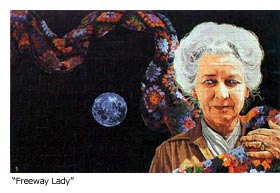
“It was almost like if I didn’t, public art would have taken a hit,” he says. “I was put in a corner. I had to fight.”
Gone, too, is “Freeway Lady,” the grandmother draped with a colorful afghan, though Twitchell plans to repaint and install her on the campus of L.A. Valley College after the Patriotic Hall work is completed. He’s also finishing up a painting of John F. Kennedy for an upcoming show at the Vincent Price Gallery at East L.A. College, where Twitchell was a student, along with Cal State L.A. and what is now the Otis College of Art and Design. The JFK portrait is an offshoot of a Berlin Wall installation that Twitchell created for the Wende Museum of the Cold War.
“I love public art, and have ever since the hippie days in London,” says Twitchell, 67. “L.A. just seemed like the perfect place for it in the ‘60s.”
Twitchell’s Flickr photostream provides a vivid look at his work, past and present. (Amazingly, given the scale of his pieces, his tool of choice for applying acrylic emulsion is generally a No. 5 or No. 6 watercolor brush.)
Twitchell, who moved to L.A. in 1966 after a stopover in Atlanta following his London tour of duty, currently lives in Hollywood. He bemoans the incivility of modern-day street life in the city, and doubts he could have created the same body of work if he was starting out today. City restrictions on building signage are an understandable response to visual pollution, he says—“L.A.’s starting to look like ‘Blade Runner,’ ”—but they also make large scale outdoor art a virtual impossibility.
Then there are the taggers—gang-affiliated and wannabes—who routinely disfigure public artwork.
“Doing things outside is enemy territory now,” he says. “It’s foolhardy.”
He laments “the destruction of so many pieces that I put my heart and soul in,” and says: “What they’re doing is by definition barbaric. It takes months to create and minutes to destroy.”
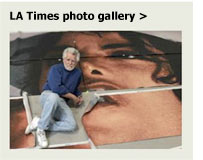 Working indoors on the Patriotic Hall project will provide a lasting refuge for his art. He said he has shied away from government commissions in the past—“I’ve always refused to compete with other artists”—but decided that this one was worth going for.
Working indoors on the Patriotic Hall project will provide a lasting refuge for his art. He said he has shied away from government commissions in the past—“I’ve always refused to compete with other artists”—but decided that this one was worth going for.
“It just seemed like this was a chance,” he says, “to do a very, very unique piece.”
The show will go on for arts interns [updated]
March 23, 2010
The county’s on-again, off-again summer arts internship program is on again.
And not a moment too soon for local arts organizations scrambling to fill spots that have been in limbo since a proposal to fund the program out of county reserves first went before the Board of Supervisors on March 2.
Since then, members of the board have suggested tapping the civic arts program for funding, debated loaning the arts commission money for this summer’s internships, and sharply questioned whether the commission had done enough to raise money from outside sources or had fully explored drawing on Temporary Assistance for Needy Families (TANF) welfare funding to give jobless single mothers a chance to take part.
The board voted 3-0 to approve a motion by Supervisor Mark Ridley-Thomas, seconded by Supervisor Zev Yaroslavsky, to spend $250,000 in county reserves to make a go of this summer’s paid internship program. Also voting in favor of the motion was Supervisor Michael D. Antonovich. Supervisor Don Knabe abstained, and Chair Gloria Molina—the board’s most ardent advocate of the TANF option—voted “no, with attitude.”
After the vote, the arts commission started spreading the word to intern-seeking organizations. Some had been calling anxiously in recent weeks to inquire about the program’s future.
“Fantastic!” said Elise Dewsberry, artistic director of the Academy for New Musical Theatre in North Hollywood, when she learned of the board’s vote to keep the program afloat for another summer. Dewsberry said last summer’s intern was a whiz at social networking and showed the organization how to create inexpensive, effective advertising campaigns on Facebook.
“We got a lot of people clicking through to our website,” she said.
The Virginia Avenue Project, which runs an after-school arts program for students in Santa Monica and Los Angeles schools, also has been hoping to land another intern this summer.
“I wouldn’t have the job I have now without the opportunity to show the organization how we would work together,” said Simon Hanna, a former summer arts intern who is now Virginia Avenue’s director of development. “I think it’s a stellar program.”
The stripped-down internship program will put 75 college undergrads to work this summer, down from about 120 the year before. The program’s funding–$500,000 last year–was cut in half, with concessions and contributions required from participating arts organizations. In the end, the money came from the county’s “provisional financing uses” account, the same funding source proposed when the matter first came before the board.
“We’re going to implement this as if it was shot from a cannon,” Laura Zucker, executive director of the Arts Commission, said after the meeting. “We’re all grappling with what the budget’s going to look like for next year. I greatly appreciate the board’s providing the support to continue, even in this reduced form.”
Posted 3/23/10
Updated 3/25/10:
Nonprofit arts organizations interested in taking part in this summer’s internship program have until April 7 to apply. Complete information is here.
Updated 4/28/2010:
There’s still time to apply for a summer arts internship. College students can find out about available positions and get program information here.
Arts internships still up in the air
March 2, 2010
The curtain could come down on L.A. County’s long-running arts internship program this summer, after the Board of Supervisors, wary of an impending fiscal crunch, voted Tuesday to move consideration of the program’s fate into upcoming budget deliberations unless money can be found to support it in the county’s civic art program.
Because of the short timetable for placing interns in summer arts jobs, supporters say that moving the program into budget talks for next fiscal year would effectively kill it.
Supervisors asked the Chief Executive Officer to report back next week on the possibility of using money to fund this year’s internships from the county’s Civic Art Program, which allocates 1% of the budget of new capital projects for the installation of art in and around them.
The CEO had recommended that the board adopt a stripped-down version of the program that would have put 75 college undergrads to work this summer. The program’s funding–$500,000 last year–was to have been cut in half, with concessions and contributions required from participating arts organizations.
But coming up with $250,000 from county reserves was too much for the board majority in the current economic climate.
“It’s going to be a very tough year for us,” board chair Gloria Molina said. “We’re going to be facing some unbelievable challenges.”
She, like other supervisors, praised the internship program. But she suggested that the arts commission and the organizations that employ arts interns needed to do more to tap into Temporary Assistance for Needy Families (TANF) welfare funding to fill their positions this summer.
Molina said the TANF recipients include single mothers getting back into the work force, with children depending on their paychecks. “They might not be the bright young college interns,” Molina said. “They are needy families…who need some help.”
She said the TANF program has created 4,566 temporary subsidized jobs in the private and public sector–more than 1,100 of them in Los Angeles County workforce, from the parks department to the Registrar-Recorder.
“I do hope that the arts community will step up and take advantage of this wonderful program,” Molina said.
Searching for compromise, Supervisor Zev Yaroslavsky briefly suggested that the county put up $125,000 for this summer’s program, with another $125,000 coming from TANF. Then Supervisor Don Knabe offered a motion to investigate using funding from the civic arts program, and, if that proves impossible, including the program in the overall budget debate. That motion passed 3-2, with Supervisors Yaroslavsky and Mark Ridley-Thomas voting against it.
In its 10 years of existence, more than 1,100 college undergrads have taken part in the summer arts internship program. Many of the participants are pursuing studies they hope will lead to careers in the arts. Some end up being hired by the organizations for which they interned.
In the Hall of Administration lobby after the vote, supporters of the internship program, many wearing red-and-white stickers reading “Art Feeds LA,” said they were disappointed and puzzled.
“It’s a little bit head-scratching,” said Cynthia Campoy-Brophy of The HeArt Project, which provides arts education for teens in continuation high schools. “We know there’s a budget crisis, but this is such a win-win project that leverages such great benefits for the entire community.”
Danielle Brazell, executive director of the nonprofit organization Arts for L.A., which mobilized former and potential interns to speak out in favor of the program, said floating the notion of using TANF for arts internships “is really positioning apples and oranges.” The CEO report to the board had said that the TANF option was not an ideal fit for the arts internship program because of limitations it placed on which students could take part, and complications involving their compensation.
Immediately after the vote, Laura Zucker, executive director of the County Arts Commission, said she needed more time to reflect on the board’s decision before commenting. “OK, to be continued,” she told the group in the lobby.
Reached later, she said, “I think that we need to weigh the options that the board put forward.”
Posted 3/2/10
Encore for summer arts interns… maybe
February 25, 2010
Here’s what Lisa Dring got out of her arts internship at Circle X Theatre last summer: The chance to produce a reading of a work called “punkplay.” Some grant-writing experience. An associate producer’s credit on the one-man show “Violators Will Be Violated.”
Here’s what else she got: a job.
Dring was one of more than 120 paid interns who worked in Los Angeles arts and cultural institutions last summer, part of a long-running county program that has been targeted for closure due to budget constraints.
Now it looks as if the program—cut from this year’s budget—could get a one-year reprieve.
Under a plan being presented to the Board of Supervisors on March 2, a stripped-down version of the program would put 75 college undergrads to work this summer. The program’s funding would be cut in half—to $250,000, transferred from county reserves—and concessions and contributions would be required from participating arts organizations. The interns would be paid $3,500 for 10 weeks of fulltime work.
“It’s a good thing, and it’s important for the economy right now,” said Arts Commission executive director Laura Zucker. “It’s jobs. Jobs, jobs, jobs…It’s saying ‘We’re not going to stop thinking about the future.’ The creative economy is at the center of Los Angeles’ economy.”
Arts for L.A., a nonprofit arts advocacy organization, is asking former interns and other supporters to write letters and attend Tuesday’s meeting to show their backing for the program.
“It was absolutely amazing. I cannot advocate enough for the program,” said Dring, 22, a recent USC grad who is now on staff at Circle X Theatre as communications director/development associate. She said that she was able to plunge into significant work—“I didn’t get anybody coffee or anything”—almost from the very start of the internship. “I got to do everything.”
“It really helps, no matter what profession someone is going into, to really see firsthand what it takes to create art in this town,” said Circle X’s artistic director, Tim Wright, who has been the company’s intern supervisor for the past 10 years. “I can’t say enough how much the L.A. County arts internship program has meant to us…I’d hate to see it go away.”
“We’ve had an incredible crop of really talented young people,” added Amina Sanchez, associate director of the program department at the Skirball Cultural Center. “They’ve enabled us to present our major summer programs. We can’t do without our interns.”
Laura Katz, a UCLA grad and an intern at the Skirball last summer, worked on its free Sunset Concerts series. She called it “a really great way to get a real work experience,” since it was a fulltime, paid position. Katz, who hopes one day to work as a film music supervisor, said she also enjoyed having contact with world musicians like Issa Bagayogo, from Mali, when they performed at the Skirball.
At Tia Chucha’s Centro Cultural in Sylmar, operations director Trini Rodriguez said it was a dream come true when Stacy Valdez became an intern in the nonprofit’s bookstore last summer. Here was someone who loved books, was in touch with the community and could work with software programs to create business analysis and inventory management reports. “We just had the best fit,” Rodriguez said—such a good fit that when a staff position came open, they offered the job to Valdez. “That’s a good thing—a very good thing actually,” said Valdez, 20, who in addition to working at the bookstore is a student at Mission College.
Zucker said that many of the program’s participants, like Dring and Valdez, stay involved with the arts institutions in some capacity after their internships are up. “A few,” she said, “have become the executive directors over time.”
A Chief Executive Office report recommending restoration of this summer’s program noted that the Arts Commission had previously explored whether it could tap into Temporary Assistance for Needy Families (TANF) welfare funding to keep the program afloat. It found too many limitations on student eligibility, and complications involving compensation, to make that a feasible option. The report said that the long-term objective should be for the Arts Commission to work with local colleges to create an internship-for-credit program.
Posted 2/25/10
An “iconic” park gets ready to bloom
February 16, 2010
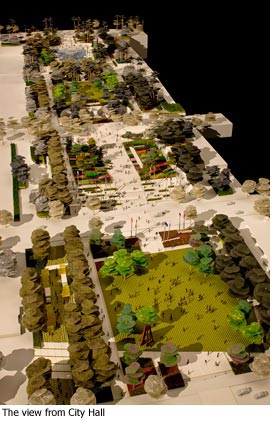 Construction of a 12-acre park envisioned as a “spectacular community gathering space” in downtown Los Angeles is set to begin this spring, under an agreement adopted Tuesday by the Los Angeles County Board of Supervisors.
Construction of a 12-acre park envisioned as a “spectacular community gathering space” in downtown Los Angeles is set to begin this spring, under an agreement adopted Tuesday by the Los Angeles County Board of Supervisors.
The Civic Park, part of the stalled Grand Avenue Project, would be built on county land running from the Music Center on Grand Avenue to City Hall on Spring Street. The $56 million project will be built on land leased by the county to the developer, The Related Companies. As part of the original agreement between the two parties, Related pre-paid some of the leasehold rent on the condition that the funds would be used to build the park and not for any other purposes. Once the park is finished, the county will have the option to purchase the property back for $1.
The project “will remake an often overlooked public space into a spectacular community gathering space that will provide an iconic park for Los Angeles,” according to a Chief Executive Office letter to supervisors asking for authorization to move ahead.
Models of the planned park depict a sweeping expanse of trees and lawns, along with plaza and terrace spaces, a dramatic fountain and a striking view toward Los Angeles’ equally iconic 1928 City Hall.
“This could be the jewel for all downtown,” Russell Brown, president of the Downtown L.A. Neighborhood Council, told the board during public comments before the vote.
The board voted 4-1 to move ahead with the park. Supervisor Michael D. Antonovich objected, citing concerns about delays in the project and reservations about the county’s agreement with Related.
With their vote, the supervisors authorized CEO William T Fujioka to sign a “lease lease-back” document and other agreements with developers, and to begin discussions on programming, operations and maintenance of the park with the Performing Arts Center of Los Angeles County.
Construction is expected to take two years, concluding in the summer of 2012.
The park will have four distinct areas: fountain plaza, performance lawn, community terrace and event lawn.
The historic Arthur J. Will Memorial fountain will be restored, and, if funds permit, “multi-cultural botanic gardens” will be added in the community terrace area to showcase plants from more than 100 “biozones” around the globe—each representing a culture present in modern day Los Angeles.
The park also will include a children’s garden and an event staging area that can accommodate community markets.
“Programming for small to large events and festivals is a crucial cornerstone of the planning of the park,” the CEO’s letter said. It noted that the park must support a range of “formal” uses such as concerts, as well as informal activities like strolling, reading and picnicking.
The developer aims to turn the steep grade of the four-block site into an asset, using “generous amphitheater steps and planted terracing” to create ADA-accessible pedestrian ramps and seating spaces.
The project will require demolition and re-engineering of ramps into the County Mall garage from Grand Avenue, relocating ramps into the Clara Shortridge Foltz Criminal Justice Center, shifting the placement of flags now located in the Court of Flags, and demolishing a surface parking lot.
Civic Center coffee aficionados, take note: the project site will be largely off-limits during construction, except for emergencies, facility maintenance and “access to Starbucks.” The Starbucks stand eventually will be demolished and the cafe relocated to a new, one-story building on the fountain plaza level, along with ATM facilities, public restrooms and park support offices.
Posted 2/16/10
Beach forecast: Sunny, splash of color
February 15, 2010
Break out the Ray-Bans. Los Angeles County’s lifeguard towers are about to undergo a Technicolor summer explosion.
From May to September, county lifeguard towers from Palos Verdes to Venice to Malibu will bloom with bright images of golden fish, blue flowers and psychedelic patterns of green, yellow, purple and pink.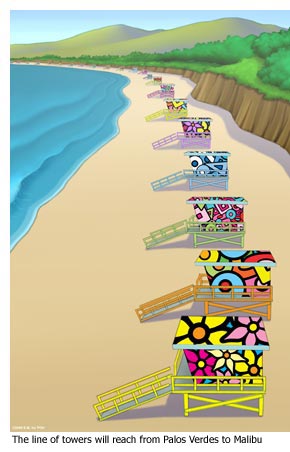
The public art display, “Summer of Color – Lifeguard Towers of Los Angeles,” is the brainchild of Bernie and Ed Massey, who run the non-profit arts and education group Portraits of Hope.
The artists applying the colorful acrylics: thousands of L.A. area children and adults from schools, shelters, hospitals, after-school programs and Scout groups. On a recent morning, young students from Palisades Elementary School pitched in, painting bright colors on some of the 1,800 pre-cut plastic panels that will be fastened to the towers this spring.
About 150 of the iconic towers will get the makeover. The project may be the most eye-catching display to hit the sand since “Baywatch.” But it’s not just a decorative addition to the beaches, which are visited by 45 million people annually. As part of the program, which is funded with private donations, students will also get an education in civic issues and problem-solving. There’s a broader social objective, too.
“We want people to recognize the power of collaboration,” says Bernie Massey. “Seeing all of the towers transformed will become a great unifying symbol for people all over Los Angeles County.”
Launched in 1995, Portraits of Hope started by wrapping the oil well on Olympic Boulevard near Beverly Hills High School with bright panels. Since then, they’ve brightened up New York City taxicabs with their trademark vibrantly colored graphics, as well as New Orleans schools, NASCAR racers, and even a blimp.
The Masseys are partnering on the project with L.A. County’s Beaches & Harbors Department, which donated temporary studio space in Marina del Rey, and the Lifeguard Division of the county Fire Department. The lifeguards had only one major demand.
No red paint.
That’s the color of the lifeguards’ signature jackets and swimsuits—and for safety’s sake, not a great color for a beachfront art installation.
If you’d like to help apply the rainbow of other colors the project will be using, drop Portraits of Hope an e-mail.
Posted 2-16-10
The fine art of saving jobs
October 27, 2009
Against the vast backdrop of the federal stimulus program, $420,084 may not seem like such a massive sum.
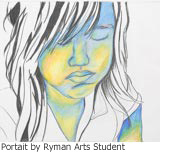 But to Tiffany Gallindo, it’s huge. It means she can keep her job on the front lines of the Ryman Arts program, working to bring a free visual arts education and college guidance to gifted Los Angeles high school students, many of them low-income.
But to Tiffany Gallindo, it’s huge. It means she can keep her job on the front lines of the Ryman Arts program, working to bring a free visual arts education and college guidance to gifted Los Angeles high school students, many of them low-income.
It means that Samuel Jang gets to continue his work as production manager for the Southwest Chamber Music Society, including helping to put together ambitious upcoming tours to Mexico and Vietnam.
And it means that Kenton J. Haleem of the Hollywood Entertainment Museum can bring back a position recently put on “hiatus”—a program manager in the organization’s media arts training program for at-risk kids.
All three organizations recently were singled out for grants of American Recovery and Reinvestment Act (ARRA) funds from the National Endowment for the Arts. The cash infusion comes thanks to the efforts of the Los Angeles County Arts Commission and the City of Los Angeles Department of Cultural Affairs, which together were able to preserve 21 positions in 16 arts organizations.
“The arts are a huge economic engine for our whole region,” says Laura Zucker, executive director of the County Arts Commission. “This is an important employer,” Zucker says, noting that the 300-plus arts organizations that are funded by the county employ more than 21,000 people.
And the importance of the organizations can be measured in more than just paychecks.
At Ryman Arts, a small nonprofit using donated studio space on the USC campus, they’re feeling the economic pains of students and recent alumni first-hand.
“Their calls and needs have been more urgent: Can we point them to more scholarship opportunities because they can’t take on more college loans? Can we arrange for them to stay after class to draw, because the electricity has been turned off at their apartment?” the organization said in its application for the grant. “Can we write another recommendation letter for a college application because they don’t have an art teacher at school?”
On the front lines is Gallindo, handling the phones, shepherding student applications, working to bring the aspiring artists and their work into the fold.
“I actually went to an arts high school,” says Gallindo, a dancer who attended Los Angeles County High School for the Arts and had been working at an insurance company before joining Ryman. “It changed my life and it opened doors. To be a part of something that is providing that opportunity to kids today is very rewarding.” (View recent student artwork on Ryman’s Flickr site).
The grant “just gives us a huge sigh of relief,” says Ryman’s executive director, Diane Brigham. “With the downturn, I had to lay off another position entirely… We’re [now] a four-person organization. And I’m really glad we’re not a three-person organization.”At the Southwest Chamber Music Society, there’s a similar mixture of excitement about upcoming projects—and concern about how to carry out an increasingly ambitious mission in an economic downturn.
On the plus side, the Los Angeles Cultural Affairs Department is sponsoring Southwest as it travels later this year to represent the U.S. at the Guadalajara FIL Arts Festival. Even more complex is next year’s State Department-sponsored Ascending Dragon Music Festival and Cultural Exchange, which will include music festivals, educational programs and administrative workshops in the U.S. and Vietnam.
“This is what we’re calling a transformative year for Southwest Chamber Music,” says Executive Director Jan Karlin, “and we needed to bring in someone to manage it.”
But because Southwest is “seeing a substantial decrease in most of our funding sources,” the federal stimulus funds were needed to pay Jang’s salary, the organization said in its application. He will not only to help manage the upcoming tours but also holds considerable responsibilities for Southwest’s musical and educational outreach throughout Los Angeles County.
Jang, whose background is in financial systems analysis and who served on Southwest’s board as treasurer before joining its staff, says he is relishing the change in perspective that comes with his new position.
“Having come from the financial services world—one of the casualties of this recession—it’s a really eye-opening opportunity for me,” he says. Working with “staff, musicians and audiences puts a more human face on this organization. Just last week, I coordinated the start of our music educational program at Keppel and Pasadena high schools.”
Across town, the Hollywood Entertainment Museum has been trying to help a new generation write its own kind of history, as 75 high school students—many of them dropouts, on probation, or otherwise “at risk”—learn the ropes of entertainment industry trades. The museum’s educational arm, the Hollywood Media Arts Academy, which is a collaboration with L.A. County Office of Education and the Probation Department, combines core academics with elective classes, including animation, dance, film production and acting.
The federal grant “can’t come soon enough,” says Haleem, the organization’s director of education and development, who says the group’s program manager had been placed on “somewhat of a hiatus.” Now that there’s money to rehire, he says, “I’m hoping she’s still available.”
“Things are tough right now,” he says. “I think that is the story of the nonprofits right now.”
In all, the NEA gave out 630 direct grants totaling $29.7 million, with $4.45 million going to California, including funds provided to the city and county commissions.To view a full list of the county and city grants, click here.




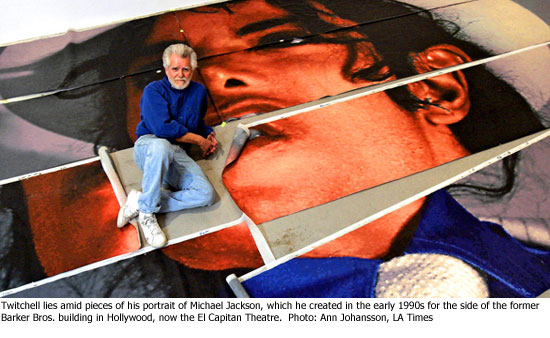
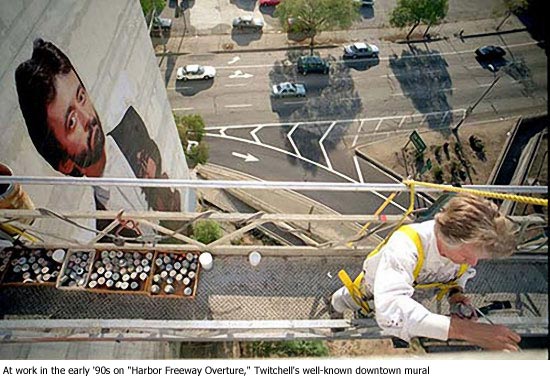
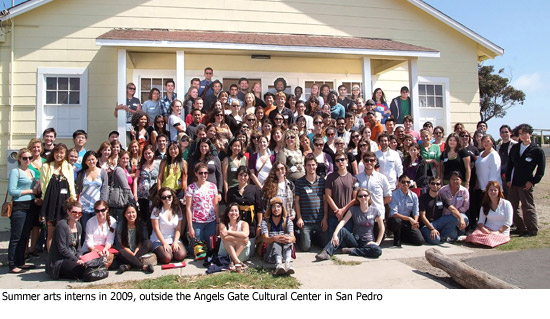
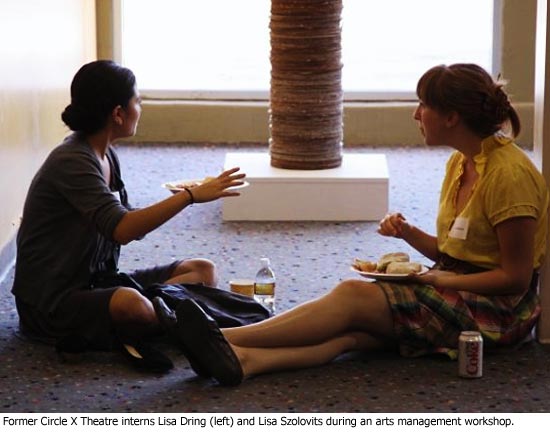
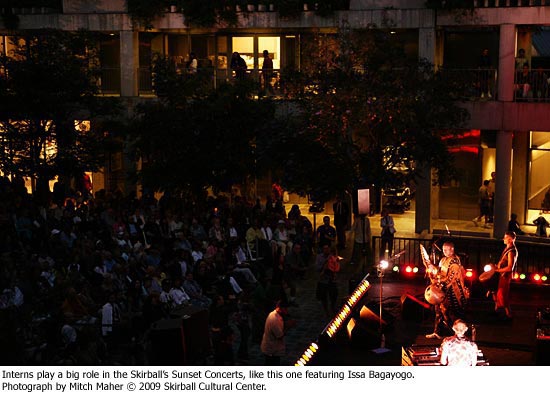
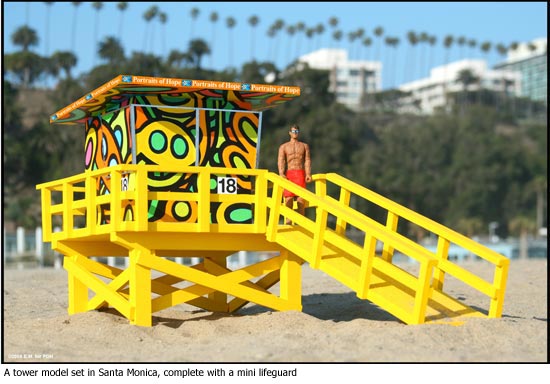












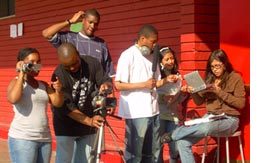









 405 bridge work causes a stink
405 bridge work causes a stink